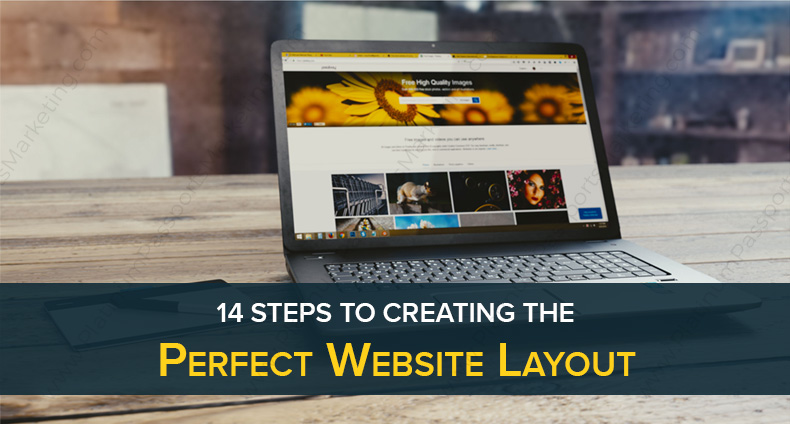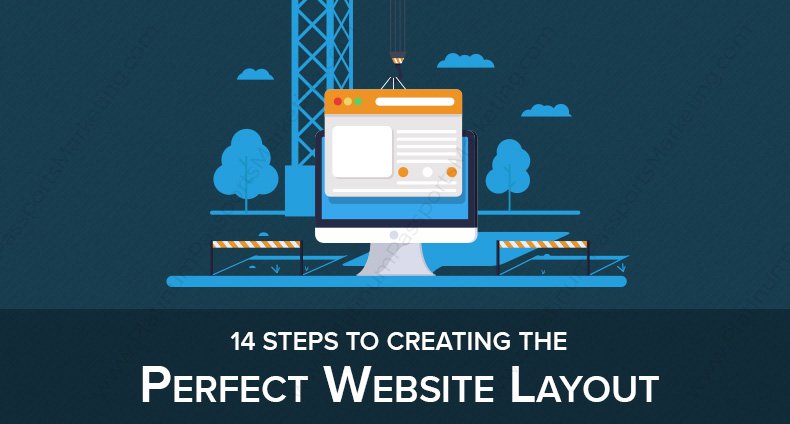The layout of your website provides the framework for how your customers interact with your business online. An attractive layout that is easy to navigate will draw people in, while unattractive, confusing layouts will drive them away. When designing your own website, it’s important to put the proper time into constructing the proper layout from the very beginning. So, here are 14 steps for the perfect website design.
Step 1: Define Your Goal
Before starting on design elements for your site, you first need to define what the goal for your site is. Different types of businesses have different goals for their sites. So, ask yourself, “What do I want my website to do for my business?” Odds are, you want the site to entice viewers to take some sort of action. Do you want them to make an online purchase, sign up for a consultation, or book an appointment?
Deciding what you want the website to do will give you a guide to designing the perfect website layout.
Step 2: Put It on Paper
While you may be tempted to jump right over to your website builder, there are still a few more things you need to do before starting to design and build your site. For now, stay away from the computer and try mapping out your site design on paper. Show the overall structure, layout, and functionality you want to shoot for.
Remember, when designing a site, you should keep your customers’ needs and desires in mind, and create a structure that will guide them naturally through the site, and make it easy to find any information they need to know on your site, as well as the things they want to see the most.
Step 3: Sketch the Top-Level Framework
Yes, you should still be working on paper (or maybe a whiteboard) at this point, but don’t worry—we’ll get to the actual website building soon enough. For now, you want to focus on the top-level framework that will support your perfect website layout. This will include elements like sidebars, bottom bars, and other navigational tools that help customers find their way through your site. Spend some time mapping out this element of the user interface, as it will provide you with a structure to follow when designing pages of your site beyond the home page.
Step 4: Use a Grid
It’s time to get on the computer. And the first thing you want to do before starting design work is to apply a grid to whatever website builder you’re using. As simple as it sounds, a grid can be a significant help for designing websites and getting the structure and layout just right. It will help you to structure the layout, guide you through screen size requirements, aid with creating responsive templates, and make sure you’re keeping consistent with spacing and other design issues.
Step 5: Choose Your Fonts
This is another one of those steps to a perfect website that too many people overlook. Though it sounds like a trivial matter, the typeface you use can make a major impact when designing a website. Though there’s no one-font-fits-all answer here, there are a few things you need to know about picking fonts for a site.
First, don’t choose more than two different typefaces for your site. Second, stick with a simple font for the main text on your site. You want it to be easy to read in large chunks. Third, don’t be afraid to use more playful and creative fonts for headers and titles. And fourth, be consistent. Once you’ve chosen your two different typefaces for your website, use them in the same way on every page.
Step 6: Pick a Color Theme
Here’s where things get more fun with designing websites for your business. It’s finally time to pick a color theme. If you already have a brand established and a company logo designed, these will likely guide your color palette decisions. The most important thing here is consistency. You want to present a consistent brand image across your website and all platforms, so pick a color theme that works well with any existing marketing materials you may have.
Step 7: Divide the Layout
Finally, we’re ready to actually start designing that perfect website layout. With your groundwork in place, you’ll now want to divide your website’s layout into simple, clear sections. Again, there’s no single answer that is going to work for every business. But ultimately, you want to divide the layout as little as possible. The simpler the structure and layout are, the easier it will be for people to navigate.
So, start with the absolute simplest layout you can imagine, and then add only the components that you believe are necessary to achieve your goal (as established in step one). You’ll be surprised by how difficult it is to keep things simple.
Step 8: Keep Movement in Mind
When designing your website, remember that website visitors are unlikely to visit a single page. In fact, you don’t want them to. You want them to move through many pages, exploring your website as much as possible. The perfect website layout is one that keeps this movement in mind, and provides a seamless, flowing experience throughout the site’s design.
With each page you design, think about how it will connect and relate to the other pages of your site. Make it an interactive experience, rather than a static one.
Step 9: Create a Solid Prototype
By repeating steps 1 through 8 on each page, you’ll eventually build a complete prototype of your website. Which means it is now time to test the interactions and coding on the pages to ensure everything works as it should. Do this again and again to learn all you need to know about navigating your own site. Identify issues, correct them, fine-tune the website’s mapping and flow, and upgrade the user interface.

Step 10: Pay Attention to Details
The difference between a decent website layout and a perfect website layout often lies in the little details. That subtle change in a button’s color when the visitor mouses over it, the unexpected animation added to the page, a little detail in the background of the site—these touches will improve the overall look of your site and leave an incredible impression on visitors.
Step 11: Refine, Sharpen, and Perfect
Now that your website is basically designed, it’s time to take steps for a perfect website—from top to bottom. Think of this step as the “Quality Control” aspect when designing a website. You should now go back and examine every component of the site you’ve built. Look at it as if it had to stand alone, as if it were the only element your website visitors were going to see. And then, make sure that it’s as impressive as can be.
Look for blurry pixels, banded gradients, or any elements that simply don’t blend well with the website design. The list of possible issues is truly endless, so you’ll have to rely on your own attention to detail to catch any issues. Additionally, make sure you’re testing out all elements of the site. Click every button, try out every interaction, and become as familiar with your site as you can.
Step 12: Organize Those Design Files
Designing websites for businesses often requires a lot of different files. Regardless of the size of your website, take some time to tidy up your design files now, and ensure they’re all organized and secure. This will make it easier to make edits to your site, and will speed up the design process in the future.
Step 13: Design for Every Viewer
Keep in mind that not every website visitor will be viewing your site on the same device you built it on. In fact, the majority of searches these days are performed on mobile devices. So, one of the most important steps to a perfect website is ensuring your website is designed for optimal performance on any device.
This goes beyond using a responsive template, however. For example, long paragraphs look exhausting when viewed on a small screen; you might want to cut down your content for your mobile site to avoid chasing away casual traffic. You may even want to use simpler images for your mobile site, in order to make it more user friendly. Ultimately, the perfect website layout is not an individual layout at all, but several—each one perfectly designed for a different screen size.
Step 14: Keep Improving
At this point, your website is ready to go live. But that doesn’t mean you’re done. There’s never really a finish line when it comes to designing websites, because you should constantly be adding new content, tweaking the structure and layout, and making edits to improve user experience. So come back to your website on a regular basis, and make improvements whenever you see the need.
Now that you know all you need to know about creating the perfect website layout, it’s time to get started. Platinum Passports Marketing offers a simple website builder tool that you can use to build your website yourself. We also offer the option to consult with a member of our team every month, to ensure you’re on the right track and to keep things moving along smoothly. Contact us to learn more about our self-builder site packages.


0 Comments